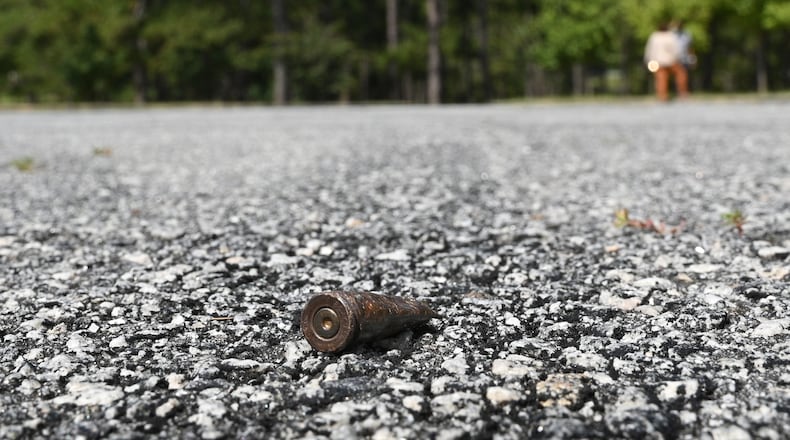Over the past two decades, Spalding County had never seen violence like it experienced last year.
The county of 67,000 had nine homicides, up from just one in 2019. So far this year, Coroner Michael Pryor said, his office has handled six.
Among the victims were two men shot at a house in Griffin. Their charred bodies were discovered in the bed of a burning pickup that had been abandoned in a remote area. Spalding Sheriff Darrell Dix called it the worst crime he’d ever seen.
“I tell people all the time, we don’t live in Mayberry anymore,” Pryor said.
Credit: Alyssa Pointer
Credit: Alyssa Pointer
At the Gold Dome, much of the discussion about the increase in gun violence the past two years has been on crime in Atlanta. A Republican-controlled House committee and Gov. Brian Kemp have blamed Atlanta leaders for “soft on crime” policies that have emboldened criminals, and the governor has called for the issue of Atlanta’s crime problem to be on the agenda of a special legislative session scheduled later this fall.
But an Atlanta Journal-Constitution examination found that cities and towns across Georgia — like many across the U.S. — have struggled with an increase in homicides last year and this. A little less than half of last year’s homicides were in the core metro counties of Clayton, Cobb, DeKalb, Fulton and Gwinnett, according to preliminary data from a state Department of Public Health office that tracks violent deaths. Those counties collectively recorded 501 homicides, a third higher than in 2019. The rest of the state recorded 556, a jump of 21%.
Driving the violence are complex social factors, exacerbated by the grind of the pandemic and a wave of social unrest over police shootings, researchers say. Officials of Georgia towns will tell you it’s poverty and isolation colliding with a broken mental health system. It’s domestic violence. Joblessness. Drugs and gangs. The prevalence of guns. The shutdown of courts. A shortage of officers.
In Laurens County, anchored by the city of Dublin, homicides tripled last year over 2019. In the small west Georgia town of LaGrange, the 10 homicides were the most in at least a quarter century. Statesboro, population 33,000, set a record with nine homicides. Macon set a modern-day record with 51, roughly double the total from the year before. Columbus set a record with 46 last year, then eclipsed it by mid-September this year with 52.
“It’s a problem — big towns, little towns,” said LaGrange Mayor Jim Thornton, who serves as president of the Georgia Municipal Association. “Obviously, Atlanta gets the headlines but it really is ubiquitous — it’s everywhere.”
Mayors and law enforcement officials know residents throughout Georgia are weary of the violence. Few see any quick-fix solutions, though.
“It’s almost like there’s been a tear in the fabric of society that has perpetrated this violence,” said Bibb County Sheriff David Davis. “It’s a problem as a society that we need to get ahead of.
“It’s a complex problem that doesn’t lend itself to simple answers.”
Neighborhood ‘terrorized’
As Columbus set new records for homicides, Carver Park on the town’s eastside became a haven for lawlessness and violence, according to residents who live in the neighborhood that abuts the 64-acre, forested enclave.
Street racers have overtaken the park. Gunfire emanates from the area day and night. Some nearby residents have found bullet holes in their homes and cars.
Deandra Bradley’s backyard faces the park. She no longer takes her kids — ages 10, 6 and 4 — to the playground because of the violence. She’s had to teach them to move away from windows and drop to the floor when they hear gunshots.
Credit: HYOSUB SHIN / AJC
Credit: HYOSUB SHIN / AJC
“Now they don’t want to live here anymore,” she said. “It’s too much: the gunshots, the ducking in the room... It’s just sad all the way around.”
Two people were slain in the park this year. One Monday afternoon in February, a 16-year-old was gunned down. Last month, a woman was killed trying to shield her 3-year-old niece when someone started shooting during a crowded event.
“A lot of people are afraid,” said Columbus Councilwoman Toyia Tucker, whose district includes the park. “The community, they are angry. They want to see something done.”
To try to cut down on the after-dark violence, Tucker pushed in February to get the city to start closing the park at 7 p.m. In response to the August killing, the city closed the park on weekends until additional safety measures can be implemented, such as more cameras.
Credit: HYOSUB SHIN / AJC
Credit: HYOSUB SHIN / AJC
Patrice Bennett hopes the city’s efforts will restore some calm but wonders if they will be enough.
“The neighborhood has been terrorized,” she said.
Her back patio overlooks the park, but she no longer feels safe sitting on it. She and her husband moved their grill out front. Before she goes to the mailbox, she tucks a gun in her waistband just in case.
After one shooting in the park earlier this year, Bennett was near her house, talking to a neighbor after police left, when a stranger came running up. He was carrying a gun and had been shot in the arm. He said people were shooting at him and he needed help. Bennett called an ambulance.
“I really hope they would just demolish Carver Park altogether,” she said. “That’s the only way I can see stopping the violence.”
The bulk of gun violence happens in a few areas in each city and involves a relatively small group of people who commit the violence or fall victim to it, said Thomas Abt, a senior fellow at the Council on Criminal Justice, who for years has studied the subject.
Credit: HYOSUB SHIN / AJC
Credit: HYOSUB SHIN / AJC
Policymakers and the local community need to understand who is driving gun violence so they can develop an effective plan, he said.
“The biggest thing is cities don’t properly understand the issue and they don’t recognize how concentrated the problem is,” said Abt, who met with Atlanta’s Anti-Violence Advisory Council created by Mayor Keisha Lance Bottoms earlier this year.
Pastors push for help
Georgia authorities have their own takes on the root causes of the violence and are trying to devise solutions accordingly.
The expansion of gangs and drugs in Dublin and Laurens County is fueling much of the violence there, said Sheriff Larry Dean. The county had 16 homicides last year, versus five in 2019.
Dean said roughly 40 of the 200 people held in his jail are gang members or affiliates. He’s now focusing more of his agency’s efforts on targeting gangs. Many residents don’t realize how embedded and organized gangs have become in the community of 47,500, he said.
“They don’t comprehend how violent it’s gotten,” he said. “Per capita, we are getting to be a dangerous city.”
In LaGrange, a town of 30,400 where 40 people have been shot since the beginning of last year, city leaders trace the problem in part to a flawed criminal justice system. Many of those involved in the violence were out of jail or prison on bond, probation or parole when they committed new acts of violence, said Thornton, the mayor.
To try to break the cycle of repeat offenders and reduce the violence, city police, courts and state parole officials are partnering in a new program to triage cases before offenders get out on parole, Thornton said.
Kemp’s office blames anti-police rhetoric from progressive leadership for creating the crisis in communities, emboldening criminals and gangs. In response, the governor has taken a strong stance in support of law enforcement, such as his anti-gang task force, spokeswoman Katie Byrd told the AJC.
“Law enforcement statewide know they have a champion in Governor Kemp,” she said.
On Thursday, Kemp surprised some when he didn’t ask for the issue to be included on the agenda for a special session this fall. His office said he would wait until January’s regular session to bring forward a package of proposals to address crime.
Abt says, however, that social factors that are driving gun violence are quite complicated and part of national trends that make it more challenging for any one community to address. Generational poverty is a significant one and most at risk are often young Black men. The events of the past year have intensified the strains on this group, he said, and contributed to the uptick in violence. Any local plan to reduce the violence, he said, must take actionable steps to reach this group.
“These disputes are often longstanding rivalries or vendettas that flare up,” Abt said. “They are under pressure like they’ve never been before. They’ve been isolated like they’ve never been before.”
Pastor Michael White has seen the complexity of the problem as it has unfolded over decades.
“It's a problem — big towns, little towns. Obviously, Atlanta gets the headlines but it really is ubiquitous — it's everywhere."
He watched as poverty took hold and changed the Avalon neighborhood in west Albany where his church, Litman Cathedral House of God Saints in Christ, sits.
He never used to fear for his safety, but that has changed, too. Gunshots have become routine. Last year, White witnessed a daytime shootout between young men in the alley behind the church. He called the police, but they were slow to respond. He rarely sees officers patrolling the neighborhood.
Credit: Alyssa Pointer
Credit: Alyssa Pointer
The pastor, 56, has never owned a gun. But he recently applied for a gun carry permit.
“Crime used to take place at night, now it’s in broad daylight,” White said. “People want to feel safe. I don’t want to die in some senseless shooting.”
The threat of violence in the neighborhood boiled over during the spring and summer. Over a three-week period in May and June, there were 10 aggravated assaults with a firearm reported in the neighborhood around White’s church, according to police records. Over a weekend in July, three shootings were reported in the area — one a block from the church. It involved the death of a 28-year-old man, whose body was riddled with bullets late on a Sunday afternoon.
Pastor Hosea Miller Jr., whose church is a few blocks away, called White after a drive-by near his church.
“I told Pastor White, ‘Did you see the news? It’s getting bad. We have to do something,’ ” Miller recalled.
Credit: Alyssa Pointer
Credit: Alyssa Pointer
That prompted the pair along with seven other pastors in the Avalon neighborhood to start meeting to discuss what can be done to end the violence. They are demanding the city do more.
Miller has also started stationing a deacon who carries a handgun at the back of his church on Sundays. Many of Miller’s congregants are older and he wants to make sure they are safe.
He recently received a call from a woman who lives nearby and had been to his church for a food drive. Her house had been shot up, and she was seeking his help to move because she no longer felt safe.
“It’s nerve-wracking,” said Miller, a retired Albany police officer. “I’m on my way to Bible study tonight, and I’m packing now. I don’t want to take any chances.”
Credit: Alyssa Pointer
Credit: Alyssa Pointer
Community effort
Some local leaders have seen success with a mix of enforcement and non-enforcement strategies.
In 2020, Macon hit a modern record for homicides when it registered 51. That was roughly double the total from 2019.
The escalation of violence occurred, Sheriff Davis said, as the pandemic put strains on many local institutions. The courts shut down, leaving as many as 80 people in his jail on murder charges and awaiting trial. His agency, like many across the state, has a shortage of deputies. He said outreach programs in the community were hampered. And the loss of school and work tore away the structure in many people’s lives.
The community was on pace this year to exceed last year’s total when leaders in June launched the Macon Violence Prevention (MVP) program. The group held more than a dozen meetings over the summer, with more than 1,000 people participating.
Macon hasn’t had a homicide since early August. Davis attributes that in part to the community awareness raised by the campaign. Efforts to be proactive with enforcement actions, including a partnership last month with the Georgia State Patrol that resulted in 64 arrests, also could have helped.
“I don’t think any one thing has done it, but several things have contributed (to the drop in violence),” Davis said.
Statesboro also worked to involve the community in reducing violence. The city and surrounding Bulloch County had two homicides in 2019 but 14 last year. Nine of last year’s homicides were in Statesboro, a record for the city of 33,000, the mayor said.
The pandemic exacerbated stresses that were already present for many in the community, especially in neighborhoods with high concentrations of poverty, said Mayor Jonathan McCollar. He said the pandemic strained the mental health of many residents and that led to some of the violence.
“It was a boiling point,” McCollar said. “Last year was sort of a perfect storm of things.”
Community leaders responded by creating a local violence prevention task force that analyzed crime reports to detect patterns. The city held listening sessions across the town. The recurring feedback was that relations had been strained between police and community. So police have worked on outreach efforts.
Elected officials also handed out masks and hand sanitizer in neighborhoods that in the past may have felt neglected or forgotten. The city also continued cleanup and revitalization efforts that had started before the pandemic.
So far this year, the city has had just one homicide.
“We’ve been very deliberate about engaging those areas of the community,” the mayor said. “It’s dangerous to have a segment of the community that feel like they’ve been left behind.”
Fear, grief, uncertainty
But violent crime trends in individual cities tend to follow the national trend, pointing to the difficulty for local communities to devise lasting solutions to societal issues.
In 1988, amid the crack epidemic and a nationwide surge in crime, Albany was dubbed the murder capital of America, with its 27 homicides giving the city the nation’s highest per-capita murder rate.
By 2012, homicides had dropped to four — a development that matched national trends of plunging homicide rates. But in the following years, the U.S. violent crime rate rose again, and in Albany the number of homicides climbed to 22.
That prompted local leaders to organize a procession of empty hearses through town, each carrying the name of a victim.
“It was bad,” Dougherty County Coroner Michael Fowler said. “We were trying to tell people to put the guns down.”
Credit: Alyssa Pointer
Credit: Alyssa Pointer
By 2019, homicides dropped to 13.
Then COVID-19 hit. Throughout the U.S., cities set records for gun violence and homicides last year. Dallas, Texas, ended the year with 251 murders, the highest in more than 15 years. Kansas City suffered its deadliest year ever, with 182 killings. Philadelphia recorded 499 homicides, the highest in 20 years. In Memphis a record 332 people were killed. Atlanta had 157 homicides, its highest total in more than two decades.
In Albany, 19 homicides were recorded, an increase of almost 50% over 2019. So far this year, the total is 14.
“You’re sickened when you hear a teenager is killed,” Mayor Bo Dorough said.
Credit: Cherokee County Sheriff's Office / Fulton County Sheriff's Office
Credit: Cherokee County Sheriff's Office / Fulton County Sheriff's Office
The violence has left residents grappling with a mix of fear, grief and uncertainty, and demanding that city leaders take action. Many are angry that the police force is understaffed, the mayor said, and want more cops on the street.
Perhaps the most wrenching slaying was that of Nigel Brown — a 9-year-old who loved Batman and had gotten a new backpack with his favorite crime-fighting superhero in anticipation of a new school year.
His family lived in the Avalon neighborhood. Around 11 p.m. on Sunday, Aug. 8, someone inside a passing car fired a barrage of gunfire.
One stray bullet pierced the window of the bedroom Nigel shared with his younger sister. She was asleep on the bottom bunk; he was on the top.
Credit: Contributed
Credit: Contributed
His mother, Yolander Brown, heard the gunfire and went to make sure her children were OK. She discovered Nigel had been struck in the head with the bullet.
His family’s days are now filled with tears that never seem to stop.
The “street” is talking, she said, about what happened to her child and who may be responsible, but no solid evidence has surfaced yet that has led to an arrest. She prays that day will come.
“I’m begging for justice,” she said. “You cannot bring my baby back. I cannot hold my child no more. And it hurts. What else is there for me to do? I’m begging for justice.”
Credit: Alyssa Pointer
Credit: Alyssa Pointer
Keep Reading
The Latest
Featured







